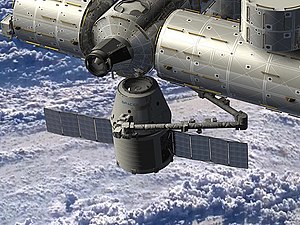SpaceX Dragon: Difference between revisions
→External links: Links to news stories? Either they are used in the article in which case they should be references, or they aren't needed and should be deleted |
Supermagle (talk | contribs) Linked SSRMS |
||
| Line 1: | Line 1: | ||
[[File:Dragon ISS.jpg|right|thumb|300px|Dragon docks with ISS (artists impression)]] |
[[File:Dragon ISS.jpg|right|thumb|300px|Dragon docks with ISS (artists impression)]] |
||
[[Image:spacexdragon.jpg|right|thumb|300px|Profiles of Dragon Cargo and Dragon Crew (NASA)]] |
[[Image:spacexdragon.jpg|right|thumb|300px|Profiles of Dragon Cargo and Dragon Crew (NASA)]] |
||
The '''SpaceX Dragon''' is a proposed conventional blunt-cone [[space capsule|ballistic capsule]] [[spacecraft]], capable of carrying seven people or a mixture of personnel and cargo, to and from [[low Earth orbit]]. The nosecone of the vehicle has a hinged cap which opens to reveal a standard ISS [[Common Berthing Mechanism]], which allows the Dragon to be captured by the SSRMS and berthed to the non-Russian segments of the [[ISS]]. The capsule is being developed by [[SpaceX]], a space transportation startup company. |
The '''SpaceX Dragon''' is a proposed conventional blunt-cone [[space capsule|ballistic capsule]] [[spacecraft]], capable of carrying seven people or a mixture of personnel and cargo, to and from [[low Earth orbit]]. The nosecone of the vehicle has a hinged cap which opens to reveal a standard ISS [[Common Berthing Mechanism]], which allows the Dragon to be captured by the [[SSRMS]] and berthed to the non-Russian segments of the [[ISS]]. The capsule is being developed by [[SpaceX]], a space transportation startup company. |
||
The Dragon capsule will be launched atop a [[Falcon 9]] vehicle.<ref name="popmech-dec06-31">{{Harvard reference | Surname=Jones Name| Given=Thomas D. | Title=Tech Watch - Resident Astronaut | Journal=Popular Mechanics | Volume=183 | Issue=12 | Mont=December|Year=2006|ID=ISSN 0032-4558| Page=31}}</ref> SpaceX has built a full-sized prototype of the vehicle and "thoroughly tested" its [[life support system]]. SpaceX CEO [[Elon Musk]] has stated that he plans to have the capsule enter service by 2009, about a year before the final flight of the [[Space Shuttle]]. |
The Dragon capsule will be launched atop a [[Falcon 9]] vehicle.<ref name="popmech-dec06-31">{{Harvard reference | Surname=Jones Name| Given=Thomas D. | Title=Tech Watch - Resident Astronaut | Journal=Popular Mechanics | Volume=183 | Issue=12 | Mont=December|Year=2006|ID=ISSN 0032-4558| Page=31}}</ref> SpaceX has built a full-sized prototype of the vehicle and "thoroughly tested" its [[life support system]]. SpaceX CEO [[Elon Musk]] has stated that he plans to have the capsule enter service by 2009, about a year before the final flight of the [[Space Shuttle]]. |
||
Revision as of 11:26, 18 February 2009

The SpaceX Dragon is a proposed conventional blunt-cone ballistic capsule spacecraft, capable of carrying seven people or a mixture of personnel and cargo, to and from low Earth orbit. The nosecone of the vehicle has a hinged cap which opens to reveal a standard ISS Common Berthing Mechanism, which allows the Dragon to be captured by the SSRMS and berthed to the non-Russian segments of the ISS. The capsule is being developed by SpaceX, a space transportation startup company.
The Dragon capsule will be launched atop a Falcon 9 vehicle.[1] SpaceX has built a full-sized prototype of the vehicle and "thoroughly tested" its life support system. SpaceX CEO Elon Musk has stated that he plans to have the capsule enter service by 2009, about a year before the final flight of the Space Shuttle.
Specifications

- Both manned and unmanned versions
- Can carry up to 7 passengers in crew configuration[2]
- Can carry over 2500 kg and 14 cubic meters in cargo configuration[2]
- 18 Draco thrusters[3]
- Phenolic impregnated carbon ablator (PICA) heat shield[3]
NASA launch partnership
Dragon is part of a proposal submitted on March 3, 2006 for NASA's Commercial Orbital Transportation Services program for commercially delivering cargo and crew to the International Space Station. SpaceX's team for the COTS proposal consists of a number of companies, including MD Robotics, a Canadian company which built the International Space Station's Mobile Servicing System, a robotic arm with a mobile re-attachable base. They intend to use the robotic arm to simplify docking with the space station, thus avoiding the added weight, extra cost and complexity of an on-board docking system such as APAS-89 or the LIDS.
On August 18, 2006, NASA announced that SpaceX had been chosen, along with Kistler Aerospace, to develop crew and cargo launch services for the International Space Station. The plan using SpaceX's Dragon capsule calls for demonstration flights between 2008 and 2010. SpaceX may receive up to $278 million if they meet all NASA milestones.[4][5][6]
NASA awarded a cargo delivery contract to SpaceX on 2008-12-23. The contract calls for a minimum of 20,000 kg of cargo over up to 12 flights to the International Space Station at a cost of $1.6 billion USD, with options that increase the maximum contract value to $3.1 billion.[7]
Development
As of December 2007[update], development of the Merlin 1C which would power the Falcon 9 have been completed and is currently undergoing qualifications.[8] Testing firings of Falcon 9's first stage have been conducted.
The Critical Design Review for the Dragon has been completed and approved by NASA. Development of mockups for aerodynamic modelling, ergonomics have been completed. Development and testing on the Dragon heat shield have started.[when?]
References
- ^ Template:Harvard reference
- ^ a b "Dragon Overview". SpaceX. Retrieved 2007-12-11.
- ^ a b "SpaceX Updates - December 10, 2007". SpaceX. December 10, 2007. Retrieved 2007-12-11.
- ^ "NASA selects crew, cargo launch partners". Spaceflight Now. August 18, 2006.
- ^ "NASA Selects Crew and Cargo Transportation to Orbit Partners". SpaceRef. August 18, 2006.
- ^ Alan Boyle (August 18, 2006). "SpaceX, Rocketplane win spaceship contest". MSNBC.
- ^ "F9/Dragon Will Replace the Cargo Transport Function of the Space Shuttle after 2010". 2008-12-23. Retrieved 2009-01-26.
{{cite web}}: Unknown parameter|source=ignored (help) - ^ "SpaceX December 2007 update". SpaceX. December 10, 2007.
External links
Photographs
- Selection of photographs from tour of SpaceX factory, including photos of Dragon capsule (Michael Belfiore's Dispatches from the Final Frontier, May 4, 2006)


